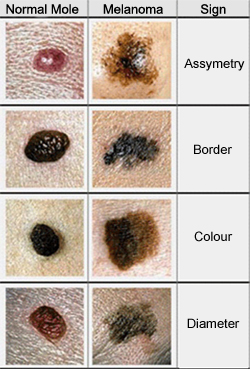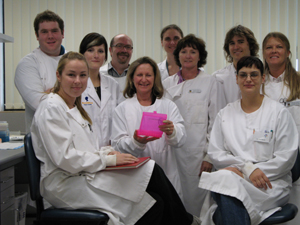How to detect skin cancer early
Melanoma is a deadly skin cancer. Most melanomas can be surgically removed and patients have a 98% five year survival rate, but if the cancer spreads, the survival rate is reduced to 10-50%. Associate Professor Melanie Ziman from the Edith Cowan Melanoma Research Foundation has been working with postgraduate students and local clinicians for over three years. She said the research team have found a way to detect the aggressive disease early – by doing a simple blood test – and this discovery, which is "believed to be a najor step forward in melanoma treatment", has the potential to save thousands of lives.
Each year about 8,000 Australians are diagnosed with melanoma. More than 1,000 of those will die.
The cancer develops from melanocytes in the skin. When we are exposed to the sun melanocytes produce more melanin, causing the skin to tan and this helps to protect the underlying cells from DNA damage. However, when we over-expose ourselves to the sun – if we are out in the sun all day without protection – we are exposed to too much UV. This UV causes DNA damage and the cells can grow abnormally and become cancerous.
Melanoma is a highly aggressive cancer that is not always easy for a general practitioner – let alone a patient – to detect, and it can rapidly spread to other parts of the body. When this happens, tumours can develop anywhere in the body and these are often not detected until too late.
It is extremely important to check and have our skin checked regularly.
What should you look for?
Melanoma can be characterised initially by its appearance: the lesion is asymmetrical in shape, the borders of the lesion are irregular, the lesion may have many colours, and generally the melanoma has a diameter greater than 2mm – the ABCD rule.

A/Prof Ziman explained that the genetic markers she is using are able to detect melanoma cells in the blood of patients. These markers are not normally found in the blood of healthy volunteers with no melanoma.
"If the cells are detected in the blood stream early it will alert the medical specialists to be extra vigilant when treating the patient, and in specific cases will ensure entry into specific treatment and chemotherapy programs. It may even provide a set of molecular targets for chemotherapy in the future.
"These exciting results are now the basis of further research aimed at detecting and understanding melanoma metastasis.
"Surprisingly and of some concern is the finding that markers of melanoma cells are still detected in the blood of patients who had melanomas removed many years ago" she said.
A/Prof Ziman is not sure whether this implies that the tumour will spread but it is without doubt that further research is urgently needed to determine the parameters that cause a melanoma cell to form a metastatic tumour in other parts of the body.
A/Prof Ziman said that to continue this research further, she "needs loads of support".
Substantial donations have been received from sponsors and local business men and women. With this assistance, a specialist postdoctoral research fellow has been employed to assist with the research. Further support is now needed to continue the employment of this researcher, as well as to fund PhD students and purchase the necessary equipment to advance the research as quickly as possible,
Supporting these excellent students and researchers helps to expand the team of dedicated scientists, taking them one step closer to ultimately benefiting all melanoma sufferers and indeed all skin cancer sufferers throughout Australia.
Performing this research in Western Australia, which has one of the highest melanoma mortality rates, would be of enormous benefit to members of the local community who are specifically involved in the research.
Collaboration is the strength behind this research team – collaborators locally at the University of Western Australia (UWA), and at Harvard University in the USA and Cambridge University in the UK support the research efforts by providing specific expertise.
Many patients willingly provide blood samples for the research. The research team is indebted to these people and their clinicians, without whose support they would not have any samples with which to work.
The ECU Melanoma Research Foundation thanks all those who have provided their support in so many ways.

You may wish to become involved in the Back a Brickie event on 1 October. To assist with funding or to become involved in supporting melanoma research please contact the ECU Melanoma Research Foundation, A/Prof Mel Ziman on 0419929851 or 63045171 or email m.ziman@ecu.edu.au or visit the website.
Dates
Tags
Created by:

 Login
Login














